
It’s an all-too-common story: you step out into your yard to enjoy the summertime, only to find your lawn overrun with unsightly weeds. If you’re in the D.C. area, you’ve probably encountered some of the many weeds that can thrive in our muggy summers – and even some that can last into the early days of autumn and winter.
From dandelions to deadnettles, we’ll go over 11 common weeds in Washington, D.C. and the surrounding counties, and teach you how to treat them. But first, let’s take a look at what types of weeds you’re likely to find in and around D.C.
8 Common Broadleaf Weeds in the D.C. Area
Broadleaf weeds are easy to identify. They stand out clearly from lawn grass, with wide leaves connected to a stem, similar to leafy green vegetables like kale and lettuce.
Here are 8 broadleaf weeds you’re likely to encounter in the DMV.
Dandelion
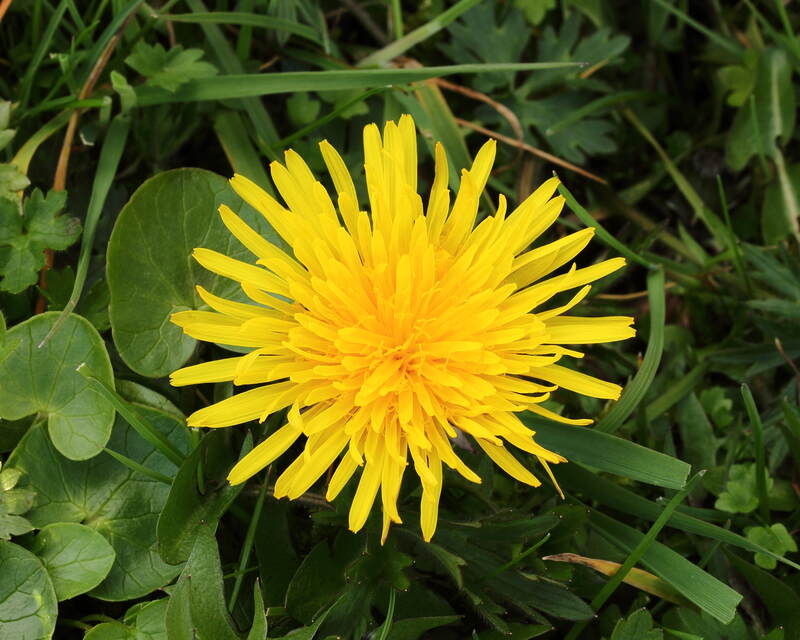
We all have fond memories of wishing on dandelions—but blowing their parachute-like seed pods into your lawn is a surefire way to see these perennial weeds popping up in your grass. They’re helpful for pollinators and bring nutrients to the surface, so some homeowners like keeping them around.
That doesn’t mean you want them to take over your lawn, though! Dandelions develop deep, fleshy tap roots in the soil, making them cold-hardy and difficult to control. They’re especially likely to spread when turf is mowed too short. To get rid of them, use tools to pull them from the ground, making sure to get the whole root, and mow the flowers before they release seeds to prevent spread.
- Peak Season: Spring
- Where It Thrives: Frequently-mowed grass in moist areas with full sun; hardy to shady, dry conditions once established
- How It Spreads: Airborne seed pods
See Related:
Annual Sow Thistle
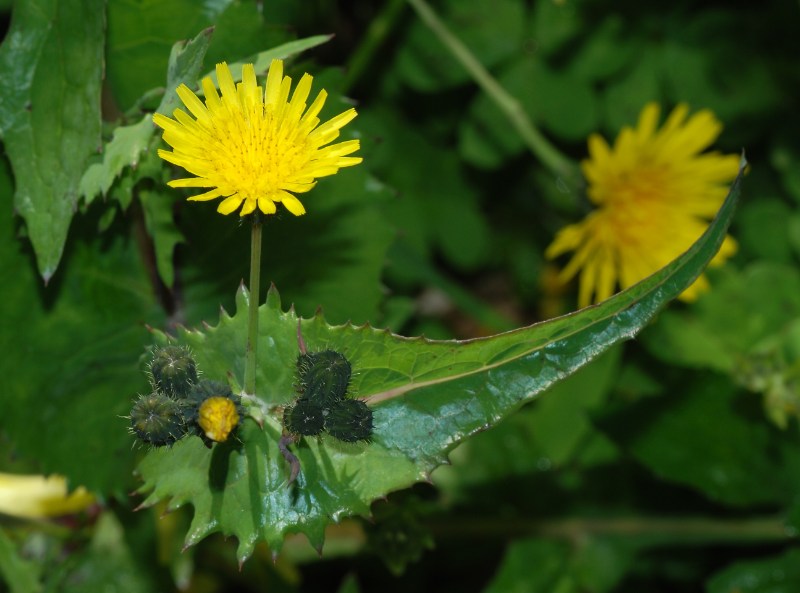
With their spiked leaves and yellow flowers that give way to white tufted seed pods, annual sow thistle is often mistaken for dandelions, but with a key difference: while dandelions grow mainly in cool weather, sow thistle favors summer. Also, while sow thistle may have multiple flowers on each stem, each dandelion stem has a single flower.
The good news is that annual sow thistle has a smaller tap root than dandelions do, making it easier to pull out from the grass if it appears in your lawn. According to Virginia Tech’s cooperative extension, mowing over the flowers will also help reduce their spread.
- Peak Season: Summer
- Where It Thrives: Areas with full sun and good drainage
- How It Spreads: Airborne seed pods
See Related: 13 Common Weeds in Virginia
White Clover
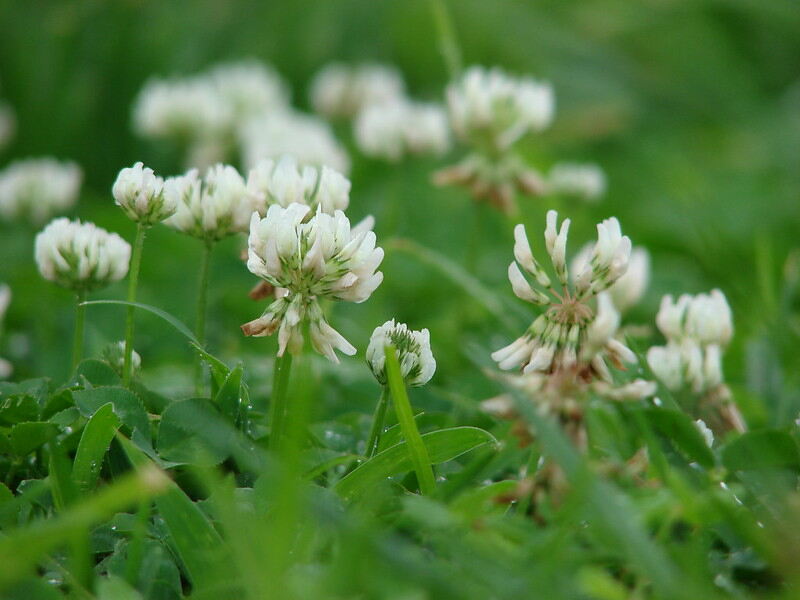
Similar to dandelion, white clover is one of those plants that some consider a weed and some don’t. Its early spring bloom time makes it helpful for pollinators, and it’s known for fixing nitrogen to soil, so some homeowners are even revamping their turf into clover lawns.
White clover is a perennial that reaches its peak blooming season in late spring and early summer, but it’s not unlikely to see it from spring to fall. Its presence may be a sign that your soil doesn’t have enough nitrogen, is compacted, or isn’t getting enough water. To get rid of white clover, test your soil’s pH and amend it to an appropriate level, and mow your grass high.
- Peak Season: Late spring to early summer
- Where It Thrives: Low-nitrogen soil, full sun
- How It Spreads: Stolons
See Related:
Purple Deadnettle

Despite its name, purple deadnettle isn’t related to stinging nettle, and it won’t “sting” you or cause a rash. This winter annual is a member of the mint family, with small purple flowers that peek out of leafy clumps at the top of its square stems. It can spread just as aggressively as other mints – especially in low-maintenance or neglected areas of the lawn with moist soil from full sun to moderate shade.
To get rid of purple deadnettle, make sure you’re mowing your grass regularly at the recommended height, and pull up any clumps that appear after rain, when the soil is loose. It can be prevented by maintaining a vigorous, healthy lawn, including dethatching as necessary.
- Peak Season: Spring
- Where It Thrives: Moist soil in full sun to moderate shade; low-maintenance or neglected areas
- How It Spreads: Stolons
See Related: 13 Common Weeds in Virginia
Plantain Weeds
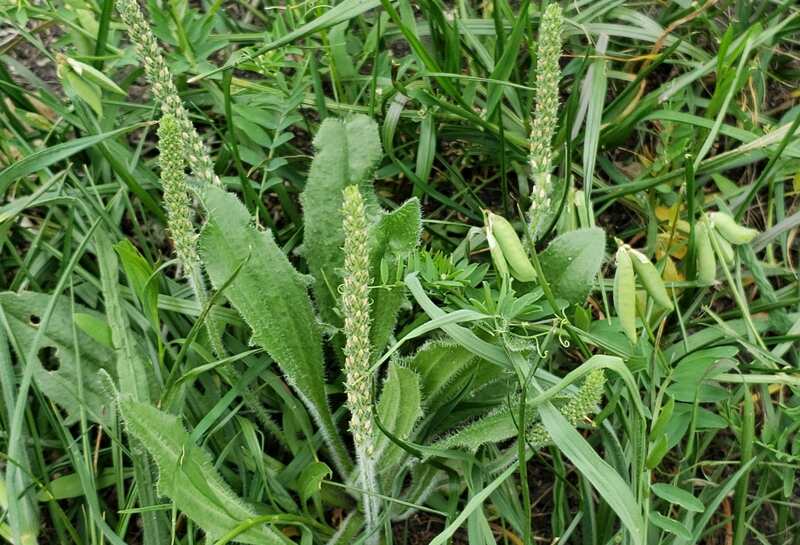
Plantain weeds, also known as plantago, are distinctive: with broad, flat leaves and tall, thick stalks, it’s not hard to spot these perennial weeds. According to Master Gardeners of Northern Virginia, the most common plantain weed varieties in the D.C. area are the native varieties broadleaf plantain and Virginia plantain, as well as nonnative common plantain and English plantain (ribgrass).
Plantain weeds have an edible and medicinal history, and they act as host plants for common buckeye butterflies and white-lined sphinx moths. They may be a sign that you have damp or compacted soil. The University of Maryland advises hand-pulling plantain clumps when they appear and maintaining healthy turf to outcompete the plantain.
- Peak Season: Midsummer to fall
- Where It Thrives: Compacted, overly damp, or dry soil
- How It Spreads: Seeds attach to people and animals
See Related: Read Your Weeds: Identify Them to Learn More About Your Lawn’s Health
Poison Ivy

Poison ivy is notorious for the painful, itchy rashes it can cause on contact with skin – caused by urushiol, which is released by its leaves, stems, and berries. It’s also a noxious weed common in the D.C. area that can show up in backyards and on the trunks of trees. You’re likely to see it at the edge of your lawn near wooded areas, in fence rows, or in shrubs and groundcovers, which UMD notes makes it difficult to spot.
Hand removal is one of the most effective ways to get rid of poison ivy in your yard, but be very careful. Wear long sleeves and protective equipment to prevent any of the oil from getting onto you, and use a shovel or trowel for larger vines. For a hands-off solution, you can try dousing vines in boiling water or a vinegar solution, or smothering and solarizing – or even hire a team of grazing goats, who’ll eat the leaves and look adorable while doing it!
- Peak Season: Spring and summer
- Where It Thrives: Near wooded areas, fence rows, in shrubs and groundcovers
- How It Spreads: Seeds spread by birds and small animals after digesting berries
See Related: How to Get Rid of Poison Ivy in Your Yard
Carpetweed
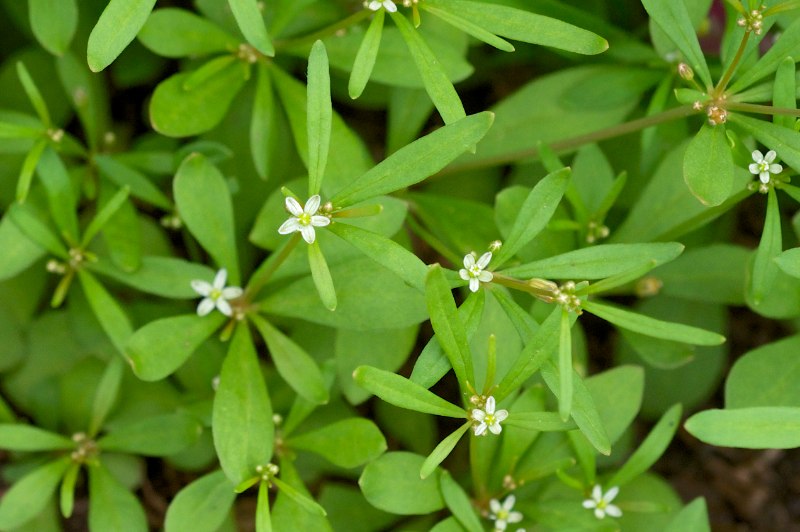
Carpetweed is a non-native weed that spreads by seeds, which are eaten by animals. As its name suggests, it can spread quickly in a lawn, creating a flat “carpet” of broad leaves in clusters of three to eight and small white flowers. It thrives in unmulched soil and unhealthy, patchy lawns.
Carpetweed germinates in late spring, and it can keep blooming until the first frost. Fairfax County Master Gardeners notes that it’s easiest to control when young, so act fast if you spot it: hand pull plants before they flower and form seeds, and cover bare soil with mulch to prevent the spread. Then, practice good lawn care so your grass will outcompete the carpetweed.
- Peak Season: Late spring to frost
- Where It Thrives: Unmulched soil, thin turf
- How It Spreads: Seeds
See Related: Lawn Care for Beginners
Spurge (Prostrate and Spotted)
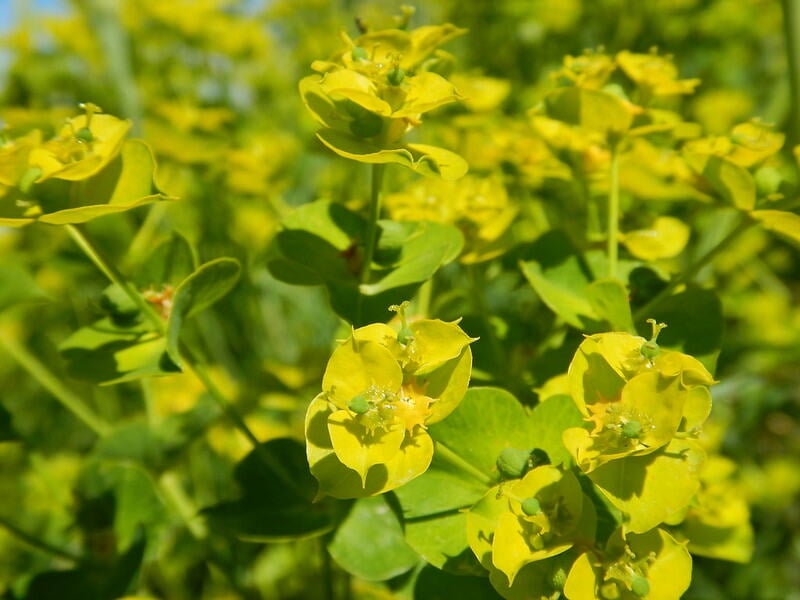
Spurge is certainly a scourge in the garden, with toxic sap that can cause irritation and hardy seeds that lie dormant in the soil until conditions are just right for them to appear. It can crop up in a flat mat of oval-shaped leaves in lawns, gardens, and even sidewalk cracks. There are two main types of spurge, prostrate and spotted, which can be distinguished by the purplish blotches in the centers of spotted spurge leaves.
Both have small white flowers and produce copious amounts of seeds. Spurge thrives in full sun and good drainage, but these hardy plants can adapt to a wide variety of conditions, particularly in compacted soil, clay, sandy, and rocky areas, and weak turf. Luckily, both varieties are easy to remove by hand pulling, and can be prevented by maintaining healthy turf and mulching in the spring.
- Peak Season: Summer
- Where It Thrives: Full sun and good drainage, but also found in compacted soil, sandy, clay, and rocky areas, and weak turf
- How It Spreads: Seeds
See Related: Read Your Weeds: Identify Them to Learn More About Your Lawn’s Health
3 Grassy Weeds Common in D.C. Lawns
Grassy weeds, true to their name, have long, narrow “blade” leaves you might confuse with your turfgrass. They can be a little harder to pick out from your turf. Here’s how to recognize the three most common grassy weeds in the D.C. area.
Crabgrass

Crabgrass is an invasive grassy weed named for its crab leg-like stolons, horizontal runner stems that shoot out from the central plant and root in the soil. These allow it to spread viciously in lawns, especially in areas where grass is thin and weak or mowed too short, or where soil is compacted.
Left unchecked, crabgrass can crowd out turfgrass and garden plants, taking up valuable nutrients and space in the soil. It can be controlled by pulling out the patches from the center and smothering and solarizing affected areas with mulch or tarp. To avoid it, maintain healthy, dense turfgrass in your lawn, and avoid soil compaction.
- Peak Season: Summer
- Where It Thrives: Compacted soil, areas with thin and weak or over-mowed grass
- How It Spreads: Stolons
See Related:
Annual Bluegrass
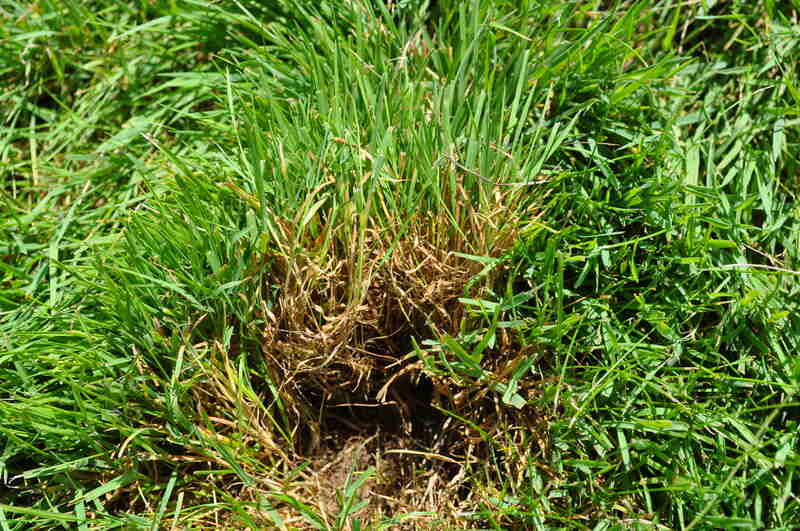
Unfortunately, annual bluegrass isn’t a music festival – it’s a common weed that mimics the appearance of Kentucky bluegrass, so much so that it can be mistakenly added to grass seed blends. Also known as “Poa” from its Latin name, Poa annua, annual bluegrass is most noticeable in early spring and will die back in the summer.
According to the University of Maryland, since it dies off naturally, you shouldn’t be too worried about eradicating annual bluegrass – but it might be a sign of compact and overly moist soil in your lawn. If you do want to get rid of it, Virginia Tech suggests mowing your turf to reduce seedhead numbers in the spring and applying a pre-emergent herbicide in early fall.
- Peak Season: Early spring
- Where It Thrives: Compact, moist soil in cool areas
- How It Spreads: Contaminated seed blends, stolons
See Related: Guide to Growing Kentucky Bluegrass
Yellow Nutsedge
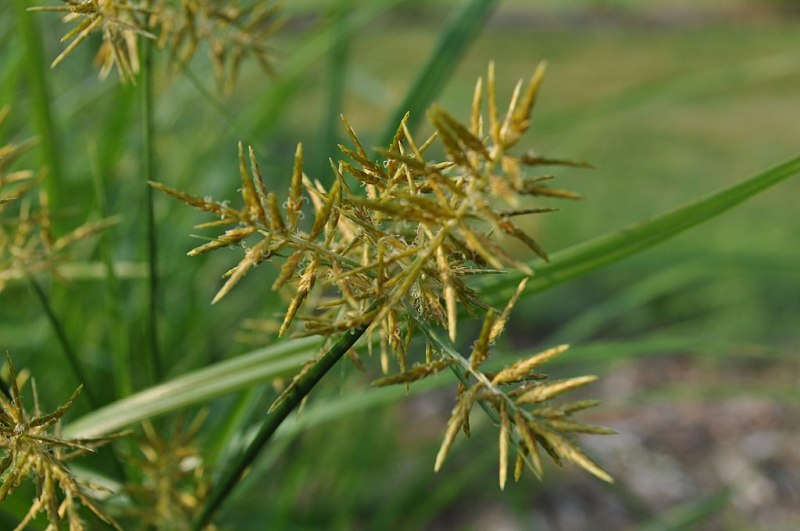
Nutsedge is widely considered one of the worst weeds to find in your lawn – it spreads quickly in lawns, is difficult to control, and can go dormant and pop back up due to tubers that it deposits into the soil. The two main varieties are yellow and purple nutsedge, but Fairfax Master Gardener Carolyn R. Casey notes that yellow nutsedge is more common in the D.C. area.
Nutsedge can make its way to your lawn through contaminated bulk soil or nursery plants, and UMD notes it’s encouraged by wet areas with poor drainage. Experts recommend a combination of lawn care, chemical, and hand-pulling treatments for nutsedge, but be warned, it’s often a lengthy process.
- Peak Season: June to frost, but tubers cause reappearance
- Where It Thrives: Overwatered soil
- How It Spreads: Tubers
See Related: How to Control Nutsedge in Your Yard
Less Weeding, More Relaxing: Call a D.C. Lawncare Pro

If you don’t want to spend your summer pulling up unsightly and irritating weeds, you’re not alone. Hiring a LawnStarter D.C. lawncare pro means you’ll spend less time weeding and more time soaking up the sun – and still have a beautiful and healthy weed-free garden.
Looking for more information about taking care of your D.C. area lawn? We can help. Check out our overview of the best turfgrass types for the D.C. area, and our tips for spring, summer, and fall lawn care to keep your lawn thriving all year round.
Main Image: White clover. Image Credit: Andrey Zyk / Adobe Stock